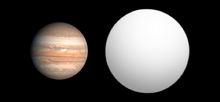astro.wikisort.org - Meteorite
CoRoT-2b (formerly known as CoRoT-Exo-2b[3]) is the second extrasolar planet to be detected by the French-led CoRoT mission, and orbits the star CoRoT-2 at a distance of 700 light years from Earth towards the constellation Aquila. Its discovery was announced on 20 December 2007.[4] After its discovery via the transit method, its mass was confirmed via the radial velocity method.
 Size comparison of CoRoT-2b with Jupiter. | |
| Discovery | |
|---|---|
| Discovered by | CoRoT mission |
| Discovery site | Earth's orbit |
| Discovery date | 2007-12-??, announced 2007-12-20 |
Detection method | Transit method |
| Orbital characteristics | |
Semi-major axis | 0.0281 ± 0.0005 AU (4,204,000 ± 75,000 km)[1] |
| Eccentricity | 0 (assumed)[1] |
Orbital period (sidereal) | 1.7429964 ± 0.0000017[1] d |
| Inclination | 87.84 ± 0.10[1] |
| Star | CoRoT-2 |
| Physical characteristics | |
Mean radius | 1.429 ± 0.047[1] RJ |
| Mass | 3.31 ± 0.16[1] MJ |
Mean density | 1,310 ± 40 kg/m3 (2,208 ± 67 lb/cu yd)[1] |
Surface gravity | 38.2 m/s2 (125 ft/s2)[2] |
| Albedo | <0.12 |
| Temperature | 1537 ± 35[1] |
Characteristics

The planet is a large hot Jupiter, about 1.43 times the radius of Jupiter and approximately 3.3 times as massive. Its huge size is due to the intense heating from its parent star, which causes the outer layers of its atmosphere to bloat. The extremely large radius of the planet indicates that CoRoT-2b is very hot, estimated to be around 1500 K, even hotter than would be expected given its location close to its parent star. This fact may be a sign of tidal heating due to interactions with another planet.[5] At Jupiter-like distances its radius would roughly be the same as Jupiter.[6] The complete phase curve of this planet has been observed.[7]
CoRoT-2b orbits its star approximately once every 1.7 days, and orbits the star in a prograde direction close to the star's equator.[8] Its parent star is a G-type star, a bit cooler than the Sun but more active. It is located about 800 light-years from Earth.
As of 2008, the CoRoT-2b spin-orbit angle (that is, the angle between the equator of the star and the plane of the planet orbit) was calculated by Bouchy et al. by means of the Rossiter–McLaughlin effect[9] with a value of +7.2 ± 4.5 degrees.[8] The spin-orbit angle was revised in 2012 to 4.0+5.9
−6.1°.[10]
References
- Alonso, R.; et al. (2008). "Transiting exoplanets from the CoRoT space mission. II. CoRoT-Exo-2b: a transiting planet around an active G star". Astronomy and Astrophysics. 482 (3): L21–L24. arXiv:0803.3207. Bibcode:2008A&A...482L..21A. doi:10.1051/0004-6361:200809431.
- Calculated using Newtonian gravity:
- Schneider, J. (10 March 2009). "Change in CoRoT planets names". Exoplanets (Mailing list). Archived from the original on 18 January 2010. Retrieved 19 March 2009.
- "COROT surprises a year after launch". Retrieved 21 December 2007.
- "CoRoT-exo-2 c?". Retrieved 21 December 2007.
- Gibor Basri; Brown (20 August 2006). "Planetesimals to Brown Dwarfs: What is a Planet?". Annu. Rev. Earth Planet. Sci. 34: 193–216. arXiv:astro-ph/0608417. Bibcode:2006AREPS..34..193B. doi:10.1146/annurev.earth.34.031405.125058.
- Cowan, Nicolas; Deming, Drake; Gillon, Michael; Knutson, Heather; Madhusudhan, Nikku; Rauscher, Emily (2011). "Phase Variations, Transits and Eclipses of the Misfit CoRoT-2b". Spitzer Proposal: 80044. Bibcode:2011sptz.prop80044C.
{{cite journal}}: CS1 maint: uses authors parameter (link) - Bouchy, F.; Queloz, D.; Deleuil, M.; Loeillet, B.; Hatzes, A. P.; Aigrain, S.; Alonso, R.; Auvergne, M.; Baglin, A.; Barge, P.; Benz, W.; Bordé, P.; Deeg, H. J.; De La Reza, R.; Dvorak, R.; Erikson, A.; Fridlund, M.; Gondoin, P.; Guillot, T.; Hébrard, G.; Jorda, L.; Lammer, H.; Léger, A.; Llebaria, A.; Magain, P.; Mayor, M.; Moutou, C.; Ollivier, M.; Pätzold, M.; et al. (2008). "Transiting exoplanets from the CoRoT space mission". Astronomy and Astrophysics. 482 (3): L25. arXiv:0803.3209. Bibcode:2008A&A...482L..25B. doi:10.1051/0004-6361:200809433.
- Joshua N. Winn (2008). "Measuring accurate transit parameters". Proceedings of the International Astronomical Union. 4: 99–109. arXiv:0807.4929. Bibcode:2009IAUS..253...99W. doi:10.1017/S174392130802629X.
- Obliquities of Hot Jupiter host stars: Evidence for tidal interactions and primordial misalignments, 2012, arXiv:1206.6105
External links
![]() Media related to COROT-2b at Wikimedia Commons
Media related to COROT-2b at Wikimedia Commons
На других языках
- [en] CoRoT-2b
[es] COROT-2b
COROT-2b (formalmente conocido como COROT-Exo-2b es el segundo planeta extrasolar detectado por el led francés COROT, orbita la estrella COROT-2 a una distancia de 930 años luzde la Tierra hacia la constelación Aquila. Su descubrimiento fue anunciado en diciembre de 2007.[ru] CoRoT-2 b
COROT-2 b (ранее известная как COROT-Exo-2 b[4]) — вторая экзопланета, обнаруженная европейским космическим телескопом COROT. Обращается вокруг звезды COROT-2, находящейся на расстоянии около 800 световых лет от Земли в созвездии Змеи. Об открытии было объявлено 20 декабря 2007 года[5].Другой контент может иметь иную лицензию. Перед использованием материалов сайта WikiSort.org внимательно изучите правила лицензирования конкретных элементов наполнения сайта.
WikiSort.org - проект по пересортировке и дополнению контента Википедии
